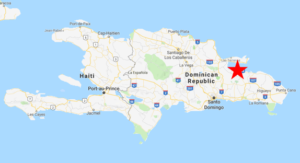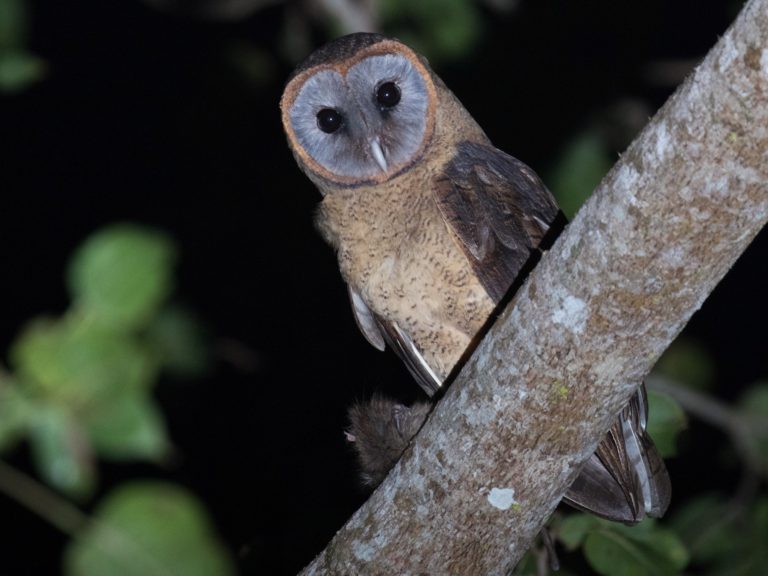Sabana de la Mar, Dominican Republic

Los Haitises National Park contains the largest block of humid lowland forest remaining on Hispaniola, and Sabana de la Mar is its easiest point of public access. Most of the park has a distinctive topography of densely packed, steep haystack hills, about 100 feet tall, with moist, flat-bottomed valleys between them. For birdwatchers, the park’s greatest significance is as the last stronghold of the critically endangered Ridgway’s Hawk, which is can be found at Sabana de la Mar.
Orientation
Directions
Sabana de la Mar is about 2 ½ hours’ drive from either Santo Domingo (130 km) or Punta Cana (150 km). In both cases the majority of the drive is on well-surfaced roads, although the route from Santo Domingo has a few rough patches between Hato Mayor del Rey and El Valle.
From Santo Domingo. Take Route 3 east from Las Americas International Airport to San Pedro de Macoris, then exit north onto Route 103, which ends at Sabana de la Mar.
From Punta Cana. Starting from the roundabout just west of Punta Cana International Airport, take Route 105 north through Bávaro and follow the signs pointing to Miches. This will bring you onto Route 104, which ends at Sabana de la Mar.
Once in the town of Sabana de la Mar, the accessible portion of Los Haitises National Park is a 15- to 20-minute drive on approximately 8 km of bumpy, but easily passable, dirt-and-gravel road. This “Carretera Caño Hondo” leads west from Route 103 one block north of its intersection with Route 104.
Attractions
Los Haitises National Park. The park is generally known to the tourist trade for its caves with pre-Columbian Taíno petroglyphs and its ragged coastline of islands and mangroves. Many excursions depart from the Samaná Peninsula across the bay, which caters to a mix of high-end and adventure tourists, but similar tours can be arranged from Sabana de la Mar as well.
As a general rule, access to the park is restricted to organized tours, and in any case it would be foolish for most tourists to attempt to explore the park without a guide.

Samaná Bay islands and coast of Los Haitises National Park. © Caño Hondo Hotel
Birdfinding
To find Ridgway’s Hawk, park at Paraíso Caño Hondo and walk the trail that leads past the right (west) side of the lodge. This trail quickly crests a saddle between two haystack hills. From this vantage point, you can survey the park’s peculiar terrain and begin looking for hawks. The population density of Ridgway’s Hawk in this locale appears to be fairly high, and they are often conspicuous as they scream and perch in the crowns of the trees. Visitors have found them from the saddle (within 50 m of the lodge), or by walking down into the first valley, then following it to the left or right, and winding around to the second valley. If the hawks do not appear promptly, the best approach is likely to plan a small circuit in either direction and walk at a leisurely pace listening for their loud calls and watching for one to fly into view. The valley floors are damp and muddy—boots are useful, but not essential.

The endangered Ridgway’s Hawk remains locally common in Los Haitises National Park. © Dax M. Román E.

The main areas of interest along Alcoa Road are between the start of the mixed forest zone and the park entrance gate.
White-necked Crows regularly visit the restaurant at Paraíso Caño Hondo to beg for food scraps, and are often conspicuously present in the area. Their peculiar vocalizations make them easy to detect at a distance.
Other uncommon or localized species that can usually be found with some effort include Plain Pigeon, Antillean Piculet, Hispaniolan Parrot, and Hispaniolan Oriole.
Most of the widespread lowland birds of Hispaniola are also present, including Hispaniolan Lizard-Cuckoo, Antillean Palm-Swift, Hispaniolan Mango, Broad-billed Tody, Hispaniolan Woodpecker, Stolid Flycatcher, Palmchat, Village Weaver, Black-crowned Palm-Tanager, and “Greater Antillean Bananaquit.”

The bizarre chortling of the White-necked Crow is a common sound at Paraíso Caño Hondo. © Gil Ewing
Approximately 1 km past Paraíso Caño Hondo, the road ends at a dock where it is possible to hire a boat for a tour of the extensive mangrove swamps that line Bahía de San Lorenzo. Spotted Rail has been found in marshy areas along this stretch of road and in the ponds on the grounds of Paraíso Caño Hondo, but it does not appear to be a permanent resident in the area.
Ashy-faced Owl occurs consistently along the road between Sabana de la Mar and Paraíso Caño Hondo. A nest has been found in a palm tree beside the road 2.3 km from the lodge, and there appear to be multiple pairs in the area. This species is strictly nocturnal, so it is best to wait until well after sunset before searching for them.

Ashy-faced Owl along the road to Paraíso Caño Hondo. © Ross Gallardy
Services
Accommodations
On the park boundary 8 km west of Sabana de la Mar, the picturesque Paraíso Caño Hondo ecolodge is comfortable, strategically located, and traditionally the preferred option of foreign visitors.
3 km south of town, along Route 103, is the Hotel El Tres (809-556-7575), a small ranch that offers horseback riding as an activity.
Inside the town of Sabana de la Mar are a few budget options, including:
Hotel Las Colinas, at the south end of the town two blocks east of Route 103, 809-556-7801
Hotel El Triangulo, on Route 103 three blocks north of the Carretera Caño Hondo, 809-556-7264
Hotel Rancho la Cueva, six blocks north of the Carretera Caño Hondo on Calle El Seibo, 809-519-5271
Food
Among Sabana de la Mar’s several restaurants, a convenient and popular option is Fon Von Restaurant, on Route 103 one block north of the junction with Carretera Caño Hondo.
Venturing north across town to the main pier, another popular option is Restaurant Jhonson.
The largest grocery store in town is the Supermercado La Roca, one block east of Route 103 on Calle 16 de Agosto.
Notes
When to Visit
Time of year is not a major factor in planning for Sabana de la Mar. Rainfall is distributed fairly evenly around the calendar. As a rule of thumb, from December through May rainstorms tend to be strong but brief, whereas from June through November the rains tend to be less intense but more persistent.